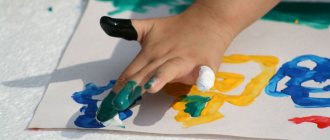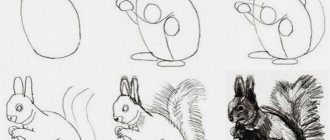Types of theaters (conversation with children of the older group about types of theater)
TYPES OF THEATER IN PRESIDENTIAL ORDER
«Theater is a magical world
in which the child rejoices while playing,
and while playing, he learns about his surroundings..."
O.P. Radynova
Finger and mitten theater
These are dolls made of fabric, glued from paper or knitted from wool and thread. The pattern follows the contour of an outstretched finger of an adult or child or the contour of the palm. The doll should fit freely on any finger or hand of the puppeteer. The character's face can be embroidered, glued or sewn on using buttons, beads, threads, ropes, pieces of wool, colored paper, fabric. Children play behind a screen or in direct contact. For a finger theater, together with your child, you can draw or glue any character from a fairy tale from colored paper, then stick it on thin cardboard, and sew or glue a wide elastic band on the back side, put it on your finger and play. For the mitten theater, you can use unnecessary children's mittens. Each child involved in the performance works with only one doll. Children find intonations and movements of a particular character on their own or with the help of an adult. The performance is well accompanied by music or songs that children know.
Mitten dolls
Puppets for this theater can be made from sewn or knitted mittens, but mitten dolls made of paper are of particular interest to children. Children place the pattern on paper, trace it, carefully cut it out and glue it together. Then the mitten dolls are decorated with paints, felt-tip pens, appliqué, etc. You can even make part of the decorations on such mittens, for example, trees, bushes and much more.
Bi-ba-bo puppet theater (or "Petrushki" theater)
The Petrushki Theater is a theater whose puppets are worn on three full fingers of the hand - like a glove. In Italy, these dolls used to be called burattini, now they are called pupattza. In Russia, this puppet character was named Petrushka. Petrushka traveled from fair to fair for a long time, until in 1924 he finally found his home in St. Petersburg. And it was then that a permanent puppet theater for children was organized. These dolls can be purchased at children's stores or made by yourself. The simplest doll consists of a shirt body, a head and arms. The body-shirt is cut from fabric according to the puppeteer's hand. The head can be made of different materials: wood, bread, plasticine, a plastic ball, but usually papier-mâché. Or you can use old dolls or rubber toys that you may be planning to throw away. If you take the head of a rubber doll and sew a new costume onto it (so that a child’s hand fits through it), then the doll will come to life, and it can be used in theatrical performances.
The doll is put on like this: on the index finger - the head, and on the thumb and middle finger - the arms or paws. The stage of the parsley theater is a screen. The scenery is placed on it, and the action takes place. Behind the screen there are puppeteers who control the puppets and speak for them.
Puppet theater brings children a lot of joy and pleasure, creates a good mood in them and is vividly reflected in their creative games.
Tabletop theater, toy theater
These are flat or ordinary toys that children play with every day. Stage area - children's table. You can make a character for a tabletop theater yourself from any available material: pine cones, acorns, roots; from household materials: milk and kefir bags, shoe boxes. If you take old skittles and cut off the bottom, and then trim or tie them, you will get a tabletop theater puppet. To decorate the doll, buttons, beads, wool, fabric, specially tied ears, noses, eyes, hair, paws and tails are used….
These dolls can be put on your hand, on a gapit, or on a thread.
The teacher sits at the children's table, and the children sit in a semicircle in front of him. Children should not see the toys that the teacher will use to show the performance. The teacher, without masking his hands, takes toys in front of the children, moves them and speaks for them.
Such a performance of toys, despite its great simplicity and primitiveness, is not devoid of theatricality; Both toddlers and older children watch it with great interest.
For the performance, it is recommended to take scenes specially written for showing them with toys: “Matryoshka and Katya”, “Game of Hide and Seek”, “Adventures of Toys” and others. You can come up with similar scenes for the puppet theater yourself or use individual plots from children's literature. You just need to remember that their content should be extremely simple, without difficult, impossible actions and movements for toys. The toy show is designed for a small group of children. It is shown not in the hall at the holiday, but in the group room. The purpose of such displays is to entertain and please children, to make the doll more interesting for them, and to help them add variety to their play activities.
Shadow theater
Shadow theater is a joyful and welcome entertainment. Children love to watch how figures of people, animals and birds move on a brightly lit screen.
A fairy tale, story, poem, song can be accompanied by showing shadows. Expressive performance of musical and literary works, when skillfully demonstrated, evokes a wide variety of emotions in children.
The stage of the shadow theater is the screen. The screen frame of the shadow theater is made of wood or thick cardboard and decorated with ornaments. The screen is covered with thin white material. When shown, the shadow theater figures are pressed tightly against the material on the back of the screen. A light source is placed behind the screen. The silhouettes of the figures are made of thin cardboard and painted black on one side. Some parts of the silhouettes (arm, leg, head, etc.) can be made movable (attached with thread or wire). Pulling the string sets the figurine in motion: the arm, head, etc. are lowered or raised.
When showing silhouettes, the puppeteer's hand should not be visible. Therefore, each figurine must have an additional part by which this figurine is held. Many interesting fairy tales and other literary works loved by children can be shown in the shadow theater.
Theater on flannelgraph
Children listen and watch the illustrative display with flannelgraph with great interest. They are amazed by the unusualness of the spectacle: the pictures do not fall, they stay on the board like magic. Older children immediately begin to become interested in the technique of making pictures and the flannelgraph itself. Children are even more surprised when the teacher tells them that they themselves can show such a picture theater to the kids. Children enthusiastically begin to prepare for the upcoming performance. For illustrative display with flannelograph by older children, we can recommend the following literary works: “Toys” by A. Barto, “Toys” by A. Akhundova, “What is good and what is bad?” V. Mayakovsky, “Merry Count” by S. Marshak, “They Gave You Nothing” by N. Naydenova, “Tanya Got Lost” by Z. Alexandrova, “Once Upon a Time There Lived a Baby Elephant” by G. Tsyferov, “Ladder” by E. Shabal.
Children should know these works by heart. Each work can be told and shown by several children at once.
For this type of theater you will need a piece of plywood covered with soft flannel (preferably in two layers) - this is the screen. You can draw pictures for display yourself (these are plots or characters from fairy tales, stories), or you can cut them out of old books that can no longer be restored. They are glued onto thin cardboard, and flannel is also glued to the back side.
These pictures can be laid out and moved on the table, and if you attach a stick (gapit) to the figure, you can perform a performance using the edge of the table as a screen. Another option is also possible: a thread is attached to the top of the picture (in this case the picture is drawn on both sides) and the picture is moved near the surface of the floor, table….
Role-playing theater
This is a theater where children take on the role of a chosen character. Children, with the help of an adult or independently, act out poems, riddles, short fairy tales, and stage songs.
For better visibility, children need costumes. You can buy them in a store or sew them yourself. In kindergarten, in each group or at home, it is advisable to have a costume room, where costumes are sewn by the hands of parents and children. If you don’t know how to sew, then together with your children make masks of various characters, decorations and props.
Masque
Masks - caps - are made according to the size of the performer's head. These can be knitted hats or characters drawn on cardboard, which are attached with an elastic band around the head.
Origami Theater
These are paper figurines of fairy-tale characters.
Stomper Theater
It’s quite easy to make characters for the stomper theater from old gloves, cutting off everything unnecessary and leaving only two fingers. You can make a pattern of characters and sew them from knitwear. It is better to draw the head on cardboard, then sew it to the figure or glue it, after which the remaining details of the character are sewn on.
Theater on sticks
To make this theater you will need sticks and character silhouettes made from cardboard. The secret of the toys is that each silhouette is attached to a stick and the character is activated by turning it. Theater on a stick is interesting for children not only because it is very easy to make, but also because the actions can be depicted behind a screen or while moving freely around the room.
Literature.
1. Yulia Alekseevna Kudimova “Theatrical activities of preschool educational institutions” Published 11/06/2015 maam.ru/detskijsad/prezentacija
2. Olga Vladimirovna Khryukina article “Types of theaters in preschool educational institutions” Published on November 24, 2015. pedportal.net/po-tipu-materiala





